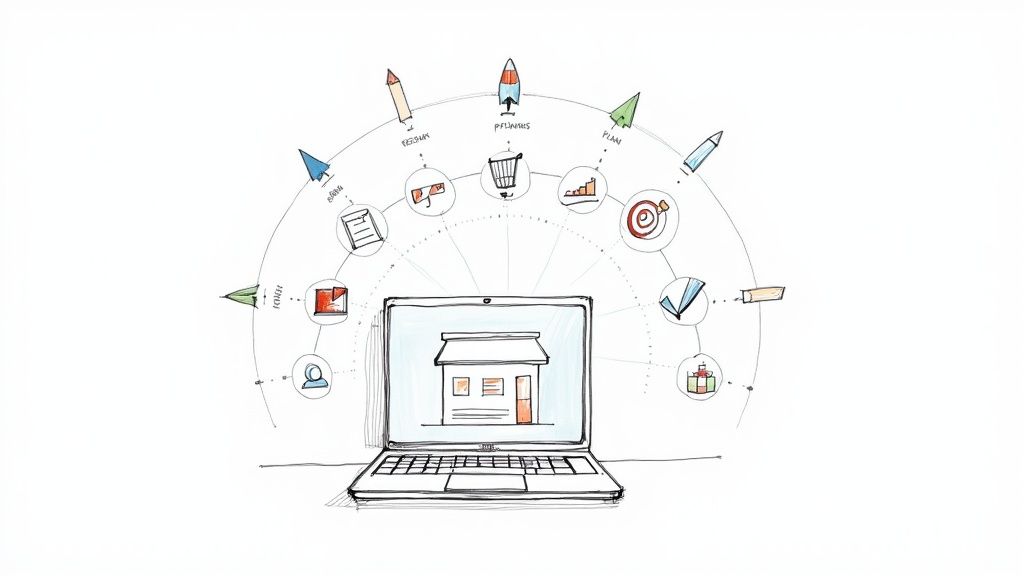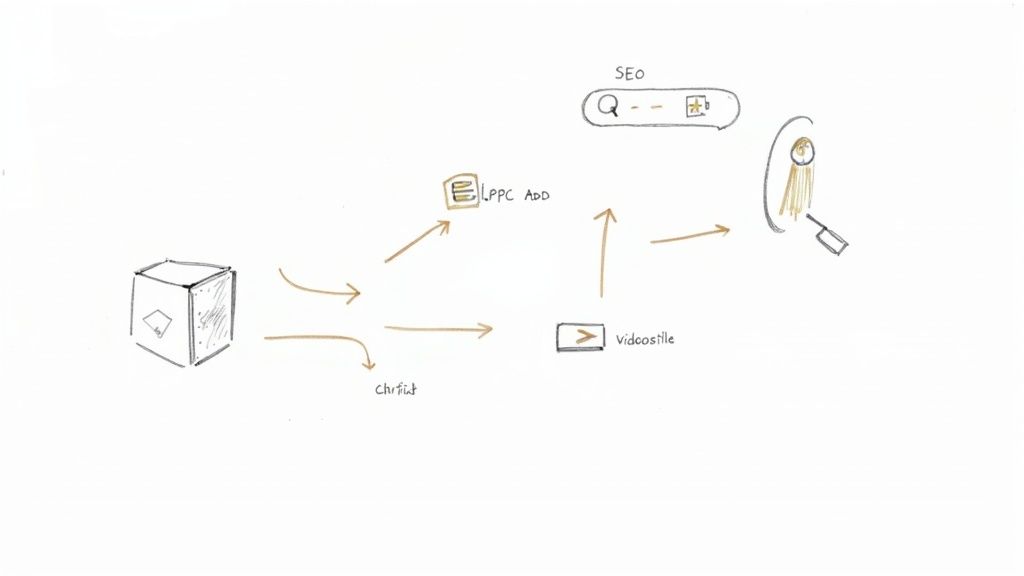
Understanding Ad Fatigue: Causes, Symptoms, and Solutions
Learn what is ad fatigue, its causes, symptoms, and effective solutions to combat it and keep your ad campaigns engaging and performing well.

A solid marketing strategy is your brand's roadmap—it's how you'll attract shoppers, turn them into customers, and keep them coming back for more. It's a blend of different tactics like SEO, content, paid ads, and social media, all working in concert to grow your online store. Every brand you admire started with a plan just like this.
Before you spend a single dollar on ads or publish a blog post, you have to get your foundation right. Great marketing isn't about guesswork; it's about deeply understanding who you're selling to and what makes your brand special.
The ecommerce world is exploding, with sales expected to soar past $7.5 trillion by 2025. That kind of growth brings a flood of competition, which makes having a rock-solid foundation absolutely essential.
First things first: who are you actually trying to reach? This is where creating detailed buyer personas comes in. You need to get inside their heads and understand their problems, what drives them, and where they hang out online. If you don't know this, your marketing will be like shouting into the void.
Once you know your audience, you can nail down your unique value proposition (UVP). What makes your brand the only logical choice? Is it your incredible product quality, your ridiculously helpful customer support, or the unique story behind your business? Your UVP is the core promise you make to every customer.
A well-defined value proposition is the cornerstone of your marketing. It's not just what you sell, but why a customer should choose to buy it from you over anyone else.
This whole process—from research to goal-setting—is a journey. It starts with understanding the landscape, carving out your unique spot in it, and then deciding what success actually looks like.

To build a strong foundation, you need to nail down a few key components. Think of them as the pillars that will support all your future marketing efforts.
Here's a quick look at the core elements you should define from day one.
Getting these pieces right at the start saves you a ton of headaches later. It ensures every campaign you run is targeted, purposeful, and has a much higher chance of success.
For a broader overview of tactics, check out these top ecommerce marketing strategies for more ideas.

Alright, you've got your foundation set. Now, it's all about bringing the right kind of shoppers to your digital front door. A great marketing strategy for ecommerce isn't about shouting into the void and hoping someone hears you. It's about precision.
We're talking about attracting people who are already looking for exactly what you sell. Let's dig into the core channels that deliver this high-intent traffic.
Think about how people shop. They go to Google. This is where you need to be, and you have two main ways to get there: organic and paid.
Search Engine Optimization (SEO) is your long game. It's the craft of getting your product pages to rank at the top of search results. This is a huge deal, as the first result on Google is 10 times more likely to get a click than the one in the tenth spot. It’s all about smart keyword research and creating genuinely useful content.
For a quicker hit, Pay-Per-Click (PPC) ads on platforms like Google Ads are your go-to. PPC lets you jump to the front of the line, targeting shoppers with pinpoint accuracy based on their real-time searches. The beauty is you only pay when someone clicks, making it an incredibly efficient way to get immediate traffic and sales.
Our Pro Tip: Don't think of it as SEO vs. PPC. The magic happens when you combine them. SEO builds long-term trust and organic authority, while PPC delivers instant visibility and crucial data that can inform your entire strategy.
A well-run PPC campaign can be a goldmine. The trick is managing your bids and budget so you stay profitable. To really maximize your ad spend, you'll want to explore different Google Ads bidding strategies and find the one that perfectly matches your goals.
Beyond just running ads, you need to build a real connection with people. This is where content marketing shines. It’s not about the hard sell; it’s about offering true value that pulls your ideal customers in.
Think about creating genuinely helpful blog posts, fun how-to videos, or in-depth guides that solve a real problem your audience faces. This kind of content doesn't just attract visitors—it builds the trust that turns them into loyal customers.
Social media is more than just a digital billboard for your products. It's the modern-day town square, the place where you build a real community around your brand. To truly make an impact, your ecommerce marketing strategy needs to tell a story and build genuine connections on platforms like Instagram and TikTok.
What does that look like? It means creating content that feels human. It's about showing your products being used in the real world and joining conversations your customers are already having. This is how you earn trust and turn casual followers into loyal fans who genuinely care about your brand.
Influencer marketing is an incredible way to get in front of communities that are already fired up and engaged. But here's the trick: it's not about chasing the biggest follower counts. The magic happens when you find creators who actually align with your brand's soul.
The numbers don't lie. Nearly 64% of people worldwide are on social media. And in the United States, a staggering 74% of shoppers say they're influenced by what creators recommend. This tells you everything you need to know. We've seen firsthand that micro-influencers often pack the biggest punch, which is why TikTok and Instagram are goldmines for high-impact campaigns. If you're curious about what's next, check out the 2025 marketing trends at Deloitte Digital.
The best influencer partnerships feel like a natural recommendation from a trusted friend. Authenticity is your most valuable asset—when a creator truly loves your product, their audience can tell, and that's what drives real sales.
When you find that perfect influencer match, you’re not just buying an ad; you're getting a warm introduction to a new audience that's ready to listen. For brands jumping into this space, a TikTok Shop gifting guide for brands can be a game-changer for getting your products into the right hands. It’s not just about getting more eyeballs on your products; it's about building credibility that turns into real, measurable growth.

Getting traffic to your store is just the start. The real magic happens when you turn those visitors into customers. That’s where conversion rate optimization (CRO) comes in—it’s all about making your online store an easy and enjoyable place to buy from.
Your product pages are ground zero for conversions. They can't just be a dry list of features; they need to connect with the shopper and tell a compelling story.
Think of your product page as your best salesperson, working 24/7. It has to be persuasive, helpful, and build instant trust.
Here’s what we focus on at BrandBooster.ai:
Nailing these elements is a huge first step. If you want to go even deeper, our guide on how to increase ecommerce conversion rate is packed with more tactics.
But even with flawless product pages, you have to face the biggest dream-killer in ecommerce: cart abandonment. Even with ecommerce booming, the average cart abandonment rate is still a painful 70%. That’s a massive amount of money left on the table.
The key to closing that gap is making the checkout process absurdly simple. Every unnecessary click, every confusing field, is another reason for a customer to walk away.
Here's how you fix it: slash the number of fields they have to fill out. Offer a guest checkout option so they don't have to create an account. And make sure you accept multiple payment types, especially digital wallets like Apple Pay or Google Pay.
Finally, set up a smart abandoned cart email sequence. A friendly reminder, maybe with a small discount, is often all it takes to bring them back to finish the purchase.
Let's be honest, the real magic happens after the first sale. Getting a customer to click "buy" is one thing, but turning them into a repeat buyer—someone who genuinely loves your brand—is where sustainable growth comes from. The smartest ecommerce brands know that a sale isn't the finish line; it's the starting line for a long-term relationship.
Think about it: acquiring a new customer can cost five times more than keeping an existing one. That's a huge difference. This is why the post-purchase experience is so critical. It’s your golden opportunity to build a real community around your brand.
This all starts with a thoughtful email marketing plan that does more than just blast out discount codes. A well-crafted welcome sequence can make a new customer feel like they've just joined an exclusive club. Personalized recommendations based on what they've already bought show you're actually paying attention to their tastes.
Of course, none of that matters without top-notch customer service. When you actively listen to feedback and fix problems quickly and graciously, you're not just saving a sale. You're creating a brand advocate who will go out and tell their friends how great you are.
A simple loyalty program can be incredibly effective, too. Rewarding customers with points, exclusive deals, or a first look at new products makes them feel special. It gives them a concrete reason to come back to your store instead of drifting over to a competitor.
Key Takeaway: Real brand loyalty isn't bought with discounts. It's earned through consistent, positive experiences that make customers feel seen, heard, and valued long after the package arrives.
When you nail these retention strategies, you build a powerful growth engine fueled by your most satisfied customers.
Here’s a quick breakdown of a few common tactics, their main goals, and how to measure their success.
Choosing the right mix of these tactics depends on your specific customers and business goals, but the principle is always the same: make your existing customers feel so valued they wouldn't dream of shopping anywhere else.
Jumping into ecommerce marketing always brings up a ton of questions. Let's tackle some of the big ones we hear all the time from brands trying to find their footing and scale up.
Look, there’s no one-size-fits-all answer here. But a solid rule of thumb for a new ecommerce store is to set aside 10-15% of your projected revenue for your marketing efforts. If you're an established brand and you're ready to hit the gas, that number might climb to 20% or even higher.
The right budget really comes down to your industry, your margins, and where you are in your growth journey. Instead of getting hung up on a specific number, get obsessed with your Return on Ad Spend (ROAS). A winning strategy is one that brings in more money than you spend, simple as that.
When you're just getting started, don't try to be everywhere at once. You'll just stretch yourself thin. Pick one or two channels and get really good at them. For most online stores, you can't go wrong by pairing Google Ads with email marketing.
My best advice? Focus on channels you truly own. SEO and your email list are assets that belong to you. You're not at the mercy of some social media algorithm change, which gives you much more stability in the long run.
This is the big one, and it really depends on your strategy. If you're running PPC campaigns, you could see traffic and even sales within a few hours of going live. It's fast.
On the other hand, SEO and content marketing are a slow burn. Think of it as planting a tree, not flipping a switch. You're probably looking at 4-6 months before you see a real, meaningful lift in organic traffic. But the payoff is huge—a steady stream of free, high-intent traffic that just keeps growing.
Ready to build an ecommerce marketing strategy that actually drives growth? At BrandBooster.ai, we use proprietary data and AI to get you a return on your ad spend in 60 days—guaranteed, or you don't pay. Find out how we can boost your brand at https://www.brandbooster.ai.